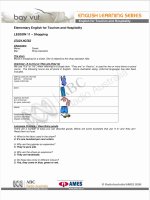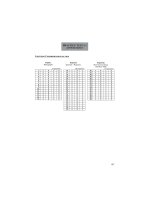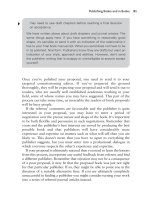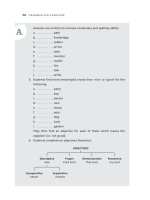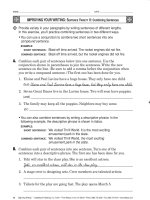4eSample poster 11 evaluation
Bạn đang xem bản rút gọn của tài liệu. Xem và tải ngay bản đầy đủ của tài liệu tại đây (19.14 KB, 2 trang )
The Effects of Gibberellic Acid on Wild-Type and Rosette Plants
Gonzalez, Hamill, Mackenzie
Presented in an introductory course for non-majors at Bucknell University
Layout and Appearance
Criteria
APPEARANCE: Is the poster neatly constructed?
Do the text and the figures stand out against the
background? Are colors and fonts used consistently? Is the text large and legible from 3–6 feet
away?
SECTIONS: Does each section begin with a descriptive heading? Is there sufficient space between
sections? Do the sections naturally flow from top
left to bottom right?
BALANCE: Is there a nice balance between text
and figures? Is there too much text?
PROOFREADING: Is the text free of typos and
grammatical errors?
Positive
Poster is neatly constructed.
Nice use of colored
paper for contrast.
Each section has a
descriptive heading.
Good use of space.
Layout flows from
top left to bottom
right.
Good balance between text and figures.
Negative
Font size of body
text could be larger.
Reduce amount of
text by using bullets
for the main points.
There are typos
and grammatical errors in the introduction.
Content
Criteria
TITLE: Does the title grab your attention?
AUTHORS: Are the authors’ names, affiliations,
and contact information provided?
INTRODUCTION: Were the objectives clearly
stated? Do you understand why this study was
done? Did you get enough background information
to understand the system? Were any abbreviations
defined for the general visitor? Were the hypotheses rational?
METHODS: Were the methods described clearly
and concisely?
RESULTS: Were the graphs easy to understand?
Were any graphics distracting?
CONCLUSIONS: Do the conclusions match the
data? Are reasonable ideas put forth to explain the
observed patterns? Is there a clear connection between the conclusions and the original objectives?
1
Positive
Authors’ names are
centered below the
title.
Objectives are
clearly stated in the
introduction.
There is a clear
connection between
the objectives and the
conclusions. The conclusions are supported
by the data. Reasonable explanations are
given for the results.
Potential sources of
error are pointed out.
Negative
Title is descriptive, but does not
hint at the results.
Use CSE in-text
citation format 1 in
the introduction
and conclusions.
Methods are incomplete; another
scientist would not
be able to repeat this
experiment. The first
and last sentences of
the methods are unnecessary.
Graph format:
delete gridlines and
gray background;
choose dark colors
for lines and symbols (the yellow line
on the gray background is barely visible). Make the y-
Council of Science Editors, Style Manual Committee. 2006. Scientific style and format: The CSE manual for authors, editors, and publishers. 7th ed. Reston (VA): The Council. 680 pp.
axis scales the same
for easier comparison.
Include captions
for photos 1–4. Include a ruler as a
scale bar.
Do not give raw
data in the results.
Instead, summarize
the data with mean
and standard deviation. Eliminate the
table, as it shows the
same data as the
graph.
Do not say “refer
to the graphs for the
results;” instead,
state in words what
the graphs show.
